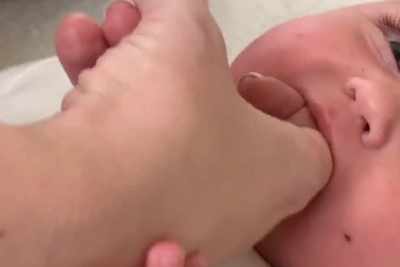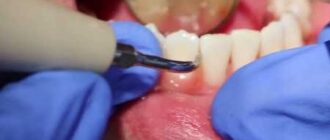Almost every baby has a moment when his or her gums swell up, and it’s a big concern for parents. Is it dangerous or not? Let’s find out.
When your baby’s teeth start to appear, usually between the ages of 6 months and 1 year, he might start to experience numerous side effects. Painful and swollen gums are typical of teething and the swelling and pain will generally go away once the tooth appears.
However, in specific circumstances, cysts or blisters on the gums might suggest that your baby is ill or has an infection. Contact your physician if you have questions about your infant’s swollen gums.
Regular Swelling
If your baby’s gums are swollen and red and you can feel a tooth beginning to erupt underneath, it is probably normal swelling. If you can’t feel a tooth coming through, take a look at the place where your baby’s gums are most swollen. The gums are generally most swollen where a tooth will emerge. The bottom front teeth generally come through first, then the leading front teeth. Next come the teeth on either side of the front teeth, and lastly the first molars and the canine teeth. If your child’s gums are swelling where the next teeth must erupt, it is most likely typical swelling.
Treating Regular Swelling
You can’t treat the swelling but you can help to ease your baby’s pain by rubbing his gums with a clean finger or a cool, clean wash cloth. Some babies prefer teething rings.
The Mayo Clinic recommends that you do not freeze the teething ring since the icy ring might cause more pain for your baby. Refrigerate it or offer it at space temperature. You can also try a nonprescription pain reliever too. Do not rub your baby’s gums with alcohol.
Atypical Swelling
In many cases, your baby might have atypical swelling on her gums. But this swelling might not be indicative of a problem, nevertheless. For example, if you discover a blue cyst-like swelling where a tooth will erupt, your baby probably has an eruption hematoma, which is a bruised area where the tooth is pressing through. Red sores and swelling might be brought on by the herpes infection, however. Because of the range of causes for swelling, call your pediatrician if you see irregular swelling or sores on your baby’s gums.
Most Common Gum Diseases in Infants
Inflammatory diseases
Gingivitis is an inflammation of the gums that occurs due to Gingivitis is an inflammation of the gums that occurs after a general or local infection. Over time, untreated gingivitis can develop into periodontitis, which is a condition where the peri-dental tissue (the bone tissue and muscle ligaments that hold the tooth in the jaw) becomes inflamed. In children, this disease is very rare, but still, preventive measures should not be neglected. If you don’t notice the development of a serious condition in time, it can lead to loosening and further loss of the tooth. If gingivitis in children is well-treatable, and you can get rid of it without consequences for health, periodontitis usually develops into a chronic form, which is practically incurable.
The inflammatory process that accompanies the granular form of periodontitis can provoke the formation of a cyst, and even a fistula on the gum. Still, these complications are more typical of carious disease of the dental tissues. No matter what, if you notice that the baby’s gums have turned bright red, and deep furrows have appeared between the teeth and gums, with foul breath coming from the baby, then most likely the inflammation has invaded not only the gums but also the deeper periodontal tissues. Contact a pediatric dentist immediately, where the doctor will promptly prescribe a comprehensive treatment.
Dystrophic diseases
Very often in infants and preschool children there is such a pathology as gum atrophy. The development of this negative phenomenon is facilitated by:
- Improperly performed orthodontic treatment;
- Trauma to the oral cavity;
- crowding of teeth;
- All kinds of bite anomalies.
Gum tissue atrophy, as a rule, is local in nature. It usually develops in the area of the canines and front incisors. The development of the disease is accompanied by mild inflammation. The child feels almost no pain and has no complaints. After some time, dystrophic changes cause the exposure of the tooth neck and root, the appearance of pathological sensitivity and severe pain.
Periodontal disease is a disease of a dystrophic nature that involves all periodontal tissues. This pathology is practically not found in children. Its development is possible only in severely ill children whose immune system is suppressed. Their body is in a state of profound avitaminosis. This disease is characterized by atrophy of the gums and other peri-tooth tissues. This incurable process can lead to the complete resorption of bone tissue. Teeth that have already become unhealthy can not be saved in most cases. Only surgery to remove the affected tooth can have some effect.
When to Consult a Pediatrician
There are a couple of warning signs that may indicate that the swelling on your baby’s gums may be connected to a more serious issue.
Contact your pediatrician right away if your baby’s swelling is accompanied by fever, a swollen or red throat or tongue, a rash on the palms and soles of her feet, blisters or sores on the face or body, or white patches. These symptoms are linked to viral infections. If your child’s tongue, throat or lips swell quickly, she may be experiencing an allergic reaction and you must call emergency situation services right away.






